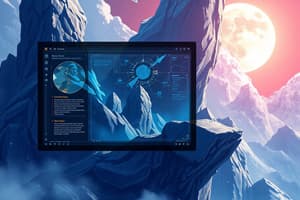Podcast
Questions and Answers
What is the main purpose of programming support tools in application development?
What is the main purpose of programming support tools in application development?
- To enhance hardware capabilities for applications
- To ensure all applications are complex and technical
- To connect hardware directly to applications
- To simplify the coding process by providing higher-level abstractions (correct)
Which architecture is considered to offer the greatest portability across different operating systems?
Which architecture is considered to offer the greatest portability across different operating systems?
- Separate Management Application (correct)
- Direct Hardware Management
- Kernel-Level Management
- Application-Level Management
Which architecture allows individual applications to manage multiple processes independently?
Which architecture allows individual applications to manage multiple processes independently?
- Kernel-Level Management
- Client-Server Architecture
- Integrated Management Architecture
- Application-Level Management (correct)
What drives the behavior of an interactive application in a client-server architecture?
What drives the behavior of an interactive application in a client-server architecture?
What is a significant drawback of Application-Level Management?
What is a significant drawback of Application-Level Management?
Flashcards
What is the role of programming support tools?
What is the role of programming support tools?
The detailed specification outlines what an interactive application must accomplish, which the programmer then translates into machine code to operate on hardware. This involves creating software that can handle input events and display graphics but this low-level approach is tedious and error-prone. Programming support tools are designed to simplify this process. These tools provide higher-level abstractions that enable programmers to code in terms of the application's interaction objects rather than the underlying hardware details.
What is the separate management application architecture?
What is the separate management application architecture?
This architecture uses a separate application that interacts with other programs through a consistent, generic interface. It offers the greatest portability across different operating systems.
What is the low-level programming approach for interactive applications?
What is the low-level programming approach for interactive applications?
The programmer writes code that directly manages the interaction between input events and the application's graphical display. This approach is tedious and error-prone, but it allows for fine-grained control over how the application interacts with the underlying hardware.
How do programming paradigms affect the application's flow of control?
How do programming paradigms affect the application's flow of control?
Signup and view all the flashcards
What is the client-server architecture?
What is the client-server architecture?
Signup and view all the flashcards
Study Notes
Implementation Support
- Detailed specifications outline interactive application requirements, translated into machine code for hardware operation.
- Software handles input events and displays graphics.
- Low-level programming is tedious and prone to errors, focusing on complex technical challenges rather than user-friendliness.
- Programming support tools simplify processes via higher-level abstractions, letting programmers focus on interaction techniques.
- Abstractions handle underlying hardware details, improving intuitiveness.
Architectures of Windowing Systems
- Bass and Coutaz identify three windowing system architectures.
- Application-Level Management: Each application manages its processes independently. This approach is less efficient due to complications in synchronization with shared hardware and reduced application portability.
- Kernel-Level Management: The operating system's kernel manages processes, centralizing control. However, applications still need tailoring to specific operating system details.
- Separate Management Application: The management function operates as a standalone application, interacting with other programs through a consistent generic interface. This offers greater portability across operating systems and is the client-server approach.
Programming the Application
- Interactive application behavior is driven by user input.
- Two programming paradigms organize application control flow:
- Read-Evaluation Loop: The application itself handles event processing. The server directs user inputs to the correct client application, handling event processing and responses..
- Notification-Based Programming: A centralized notifier manages event processing, reducing the application's burden. Provides callback procedures for application interests.
Using Toolkits
- WIMP interfaces link input/output closely to visual elements.
- Tools provide a higher level of abstraction, offering predefined interaction objects or widgets with built-in behaviors.
- Customization simplifies object behavior without manual code implementation.
- Toolkits let programmers use and customize interaction objects, contributing to the overall functionality and user experience
User Interface Management Systems (UIMS)
- Despite toolkit benefits, limitations exist (restricted interaction objects, user difficulty, even for experienced programmers). This highlights the need for further support in developing and implementing interactive systems.
- UIMS offers higher-level services.
- UIMS categorizes this into: Conceptual Architecture, Implementation Techniques, and Support Techniques.
UIMS as a Conceptual Architecture
- Interactive systems research highlights a key issue: Separating application semantics from user interface.
- The benefits include:
- Portability Allows same application to be used on different systems.
- Reusability Enhances the reusability of components, reducing development costs.
- Multiple Interfaces Enables different interface types for the same functionality.
- Customization Enables both designers and users to customize interfaces without modifying core application logic.
- Managing interaction between application and presentation is crucial. The presentation, dialog control, and application itself are primary components.
- Two primary approaches to dialog control exist:
- Read-Evaluation Loop: Application manages control.
- Notification-Based Programming: External control.
The Seeheim Model
- System supporting separation between application and presentation.
- Key aspects include Presentation, which manages interface appearance; Dialog Control, governing communication between presentation and application; Application Interface, which represents application semantics.
The Model-View-Controller Triad in Smalltalk
- Designed for large, complex interactive systems.
- MVC divides interactive systems into: Model (application semantics), View (graphical/textual output), and Controller (managing user input).
Presentation-Abstraction-Control (PAC) Model
- Multi-agent interactive systems architecture with emphasis on Abstraction, Presentation, and Control.
- Abstraction: Presents application semantics.
- Presentation: Manages input and output.
- Control: Oversees dialog management and consistency between abstraction and presentation.
- Input and Output: PAC combines input and output into a single presentation component. MVC separates these.
- Consistency Management: PAC includes explicit control for consistency; MVC leaves this to the programmer.
- Implementation Independence: PAC is a conceptual framework, not tied to specific environments.
Implementation Considerations
- Conceptual architecture differs from implementation details.
- Realization methods include specific methods for handling graphics, using callbacks, and working with MVC (Model-View-Controller) patterns, though not all employ toolkits in all cases.
- Implementation considerations involve techniques for dialog modeling, including:
- Menu Networks: Dialogs as networked menus and submenus.
- Grammar Notations: Formal grammars for command-based interfaces.
- State-Transition Diagrams: Describing dialog events, but with limitations on linking and handling visual feedback.
- Event Languages: Expressing directionality and semantic feedback; more complex in overall dialog flow
- Declarative Languages: Focus on describing application and presentation relationships.
- Constraints: Subset of declarative languages defining dependencies.
- Graphical Specifications: Direct programming of dialogs in terms of interfaces.
Elements of Windowing Systems
- Key feature: abstracts away hardware device details (screens, keyboards, mouse) to create a general, abstract terminal language.
- This abstraction promotes portable application development.
- System uses a common language (imaging model) to describe various visual elements (fonts, pixel images).
Roles of Windowing System
- The crucial role of the windowing system is managing multiple processes to run concurrently.
- Abstracts specifics of hardware devices, allowing applications to operate in a device-independent manner.
- Coordinates multiple processes, managing how they occupy separate screen regions.
Studying That Suits You
Use AI to generate personalized quizzes and flashcards to suit your learning preferences.




